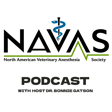
Dr. Carolyn McKune on Anesthetizing Dogs and Cats with Common Cardiac Diseases: Part 1
Get ready to follow your heart straight into another fantastic episode of the North American Veterinary Anesthesia Society Podcast! Host Dr. Bonnie Gatson is back (and pumped as ever) with a special guest who truly gets to the heart of the matter—board-certified veterinary anesthesiologist and owner of veterinary consulting business Mythos Veterinary LLC (great video explanation of what Mythos does), Dr. Carolyn McKune! This month, we’re diving deep into the world of anesthetizing dogs and cats with cardiac disease, and spoiler alert: there’s too much good stuff to fit in one beat! So, we’re splitting this topic into a TWO-PART SERIES to make sure nothing important gets left in vein. In this first episode, Dr. McKune helps us lay the groundwork by walking through the pathophysiology of common degenerative cardiac diseases seen in dogs and cats. What diagnostics will help shine a light on which anesthetic protocols are best for these patients? Which cardiac medications should be continued, and which should be left out prior to general anesthesia? If these are questions pique your interest, then this episode is sure to get your blood flowing!
Part two of this special episode on anesthetizing dogs and cats with degenerative cardiac disease will air the week of June 15th, so stay tuned!
If you like what you hear, we have a couple of favors to ask of you:
Thank you for the FANTASTIC turnout at the NAVAS Virtual Spring Symposium. If you enjoyed the educational content of the symposium, consider becoming a subscriber to NAVAS to access even more anesthesia and analgesia educational and RACE-approved CE content. When you become a subscriber to NAVAS, you'll have access to videos of all the sessions from the 2025 Annual Spring Symposium, as well as, all the other session videos from all 5 years NAVAS has presented the symposium. You can also have access to RACE-approved CE credits after you take a 5 question quiz after watching the videos.
Spread the word. Share our podcast on your socials or a discussion forum. That would really help us achieve our mission: Reduce mortality and morbidity in veterinary patients undergoing sedation, anesthesia, and analgesia through high-quality, peer-reviewed education.
Thank you to our sponsor, Dechra - learn more about the pharmaceutical products Dechra has to offer veterinary professionals, such as Zenalpha.
If you have questions about this episode or want to suggest topics for future episodes, reach out to the producers at education@mynavas.org.
All opinions stated by the host and their guests are theirs alone and do not represent the thoughts or opinions of any corporation, university, or other business or governmental entity.










